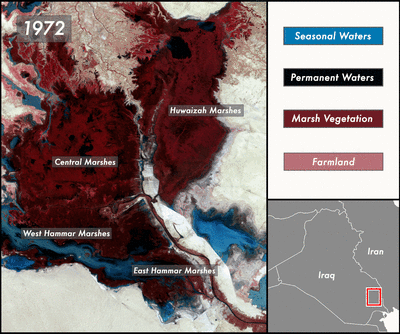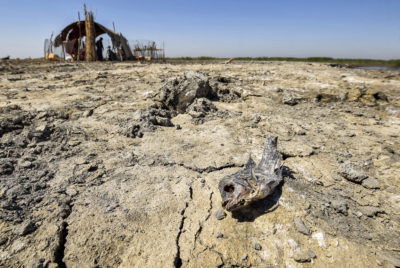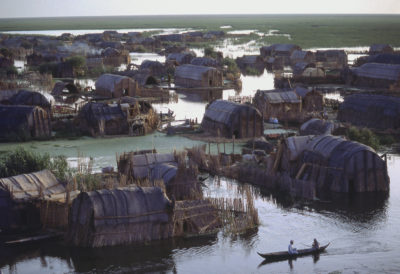Three years ago, the vast marshlands of southern Iraq’s Dhi Qar province were flourishing. Fishermen glided in punts across swathes of still water between vast reed beds, while buffalo bathed amid green vegetation. But today those wetlands, part of the vast Mesopotamian Marshes, have shriveled to narrow channels of polluted water bordered by cracked and salty earth. Hundreds of desiccated fish dot stream banks, along with the carcasses of water buffalo poisoned by saline water. Drought has parched tens of thousands of hectares of fields and orchards, and villages are emptying as farmers abandon their land.
For their biodiversity and cultural significance, the United Nations in 2016 named the Mesopotamian Marshes — which historically stretched between 15,000 and 20,000 square kilometers in the floodplain of the Tigris and Euphrates rivers — a UNESCO World Heritage Site. The marshes comprised one of the world’s largest inland delta systems, a startling oasis in an extremely hot and arid environment, home to 22 globally endangered species and 66 at-risk bird species.
But now this ecosystem — which includes alluvial salt marshes, swamps, and freshwater lakes — is collapsing due to a combination of factors meteorological, hydrological, and political. Rivers are rapidly shrinking, and agricultural soil that once grew bounties of barley and wheat, pomegranates, and dates is blowing away. The environmental disaster is harming wildlife and driving tens of thousands of Marsh Arabs, who have occupied this area for 5,000 years, to seek livelihoods elsewhere.
“The situation in the marshes now is worse than when Saddam was trying to destroy them,” an Iraqi water engineer says.
Experts warn that unless radical action is taken to ensure the region receives adequate water — and better manages what remains — southern Iraq’s marshlands will disappear, with sweeping consequences for the entire nation as farmers and pastoralists abandon their land for already crowded urban areas and loss of production leads to rising food prices.
The Mesopotamian marshlands are often referred to as the cradle of civilization, as anthropologists believe that this is where humankind, some 12,000 years ago, started its wide-scale transition from a lifestyle of hunting and gathering to one of agriculture and settlement. Encompassing four separate marshes, the region has historically been home to a unique range of fish and birdlife, serving as winter habitat for migratory birds and sustaining a productive shrimp and finfish fishery.
But in the early 1990s, Saddam Hussein began systematically destroying the marshes — bombing and draining them to evict and punish Marsh Arabs for participating in uprisings against his regime. Ultimately, the Iraqi president’s campaign reduced marsh water levels by 90 percent. After the Iraq War, the new government and Marsh Arabs began to dismantle embankments and drainage works; a subsequent U.N.-implemented rehydration project reported restoring surface water and vegetation to 58 percent of the marsh’s original size by 2006. Wildlife began reappearing, and by 2020, when the post-Saddam recovery was at its peak, around 250,000 Marsh Arabs had returned to their homeland to resume harvesting reeds, cultivating crops, herding water buffalo, and fishing.
False-color satellite images of the Mesopotamian Marshes in 1972; in 2003, after being drained by Saddam Hussein; in May 2019, after being partially restored; and in May 2022, in the third year of a severe drought. Source: Landsat 1 via U.S. Geological Survey.
Yale Environment 360
The marshlands and their surrounding buffer zones currently cover roughly 4,000 square kilometers, but recent environmental gains are newly jeopardized as Iraq enters its fourth year of drought. Upstream, in both Turkey and Iran, new dams and diversions continue to proliferate, without coordination or international cooperation, on the rivers that supply almost all of Iraq’s water.
Last July, the Iraqi government said that its water reserves had dropped by 60 percent since the previous year. The low water flows have left huge swathes of marshland completely dry. Without water for irrigation, farmers don’t plant. Without roots to hold soil, desertification looms.
“The situation in the marshes now is worse than when Saddam was trying to destroy them,” says Dr. Hayder A. Al Thamiry, a professor of water resources engineering at the University of Baghdad who works for the government’s Centre for Restoration of Iraqi Marshes and Wetlands (CRIMW). That’s because water at that time still flowed from Iran into eastern Iraq’s Huwaizah Marshes, keeping at least that portion of the system alive. But ever since Iran, in 2009, completed construction of a 56-kilometer-long weir along its border with Iraq, water no longer flows into the Huwaizah during periods of drought. Now all the marshes, says Al Thamiry, “are suffering very badly.”
Low river flows have knock-on effects on the quality of what water remains. Today, sea water intrudes as far as 189 kilometers upstream from the Persian Gulf and has destroyed more than 24,000 hectares of agricultural land and 30,000 trees. Without inundations of fresh water, pollutants from agriculture, the oil and gas industry, and sewage have become more concentrated.
Some of the displaced Marsh Arabs have abandoned their traditional way of life and moved to cities like Basra and Baghdad.
Climate change is, of course, making matters worse — diminishing rainfall (Iraq has seen record low rainfall in recent years) and increasing temperatures, which accelerate evaporation from reservoirs and streams. According to the U.N. Environment Programme, Iraq is the fifth-most vulnerable country to the impacts of climate change. “Over the last couple of years there has been consistently less rain, less water, less productivity from the land, and an increasing number of dust storms,” said Dr. Salah El Hajj Hassan, the UN’s Food and Agriculture Organization representative in Iraq.
Mismanagement takes a toll as well. Iraq’s water infrastructure hasn’t been sufficiently maintained or modernized; unlined ditches and canals leak water into the soil; and power cuts hinder water pumping and storage. Often, farmers flood their fields to irrigate, rather than using more parsimonious, targeted ways of watering, and villagers dig illegal wells and divert water from shared rivers.
The dropping water levels have caused extensive crop losses, making it increasingly difficult for millions of Iraqis to feed their families. According to a survey of households in Anbar, Basra, Dohuk, Kirkuk, and Ninewa provinces conducted by the nonprofit Norwegian Refugee Council (NRC) last summer, one quarter of respondents — in the marshlands and beyond — experienced upward of 90 percent wheat crop failure due to lack of water. One in three households surveyed reduced the area of land they cultivated, and 42 percent of households stated that their production of barley, fruit, and vegetables declined in comparison with the previous cropping season.
A dead fish on the dried earth in Iraq’s Central Marshes in June 2021.
ASAAD NIAZI / AFP via Getty Images
From the start of last summer until late October, more than 2,000 families were forced to abandon their homes due to the retreating marshlands, according to the FAO’s El-Hajj Hassan. Some of the displaced have moved to areas of marshland that still have water, while others have abandoned their traditional way of life and moved to cities like Basra or Baghdad.
Tensions among those who remain in the marshes are rising, and security consultants believe that water scarcity, and specifically the disappearance of the marshlands, could affect national security. According to Eimear Hennessy, a former risk analyst for G4S Consulting, “The thousands of people that have been uprooted and impoverished by the ongoing crisis in the Mesopotamian Marshes are likely to be more susceptible to recruitment by non-state actors” — militias and terrorist groups — “that make promises of an attractive future.”
According to Nature Iraq, the recent drying of the marshes has triggered a collapse in wildlife diversity, with populations of Binni, a brownish-gold fish highly prized by Marsh Arabs, plummeting. “Two thousand officially registered fishermen have lost their source of income and are now unemployed,” Saleh Hadi, the Dhi Qar agriculture directorate, stated in October.
Iraq has been negotiating with its neighbors to allow more water to flow across its borders, but the situation has not improved.
Before the drought, the Marbled teal duck, listed as near threatened by the International Union for Conservation of Nature, appeared to be thriving in the marshes, as was the endangered Basra Reed-warbler and the native Iraq Babbler. But with water levels dropping, Nature Iraq said, these birds are far less frequently seen.
Livestock are suffering too. Water buffalo, who graze in the rivers, now have a hard time finding clean water and sufficient food; thousands have died due to disease and malnutrition. “The lower water levels are having a devastating impact on the buffalo farmers,” said Samah Hadid, a spokesperson for the NRC. “The buffalo breeders that we are talking to are becoming increasingly desperate.”
As the outlook worsens for communities that live in Iraq’s marshlands, NGOs are promoting actions that could reduce the impact of drought, including investment in water filtering and treatment systems for areas with high salination levels. They are pushing Iraqi authorities, at the national and regional level, to collect more data on water flows and on the impacts of scarcity, and to improve the regulation of aquifers to prevent over-pumping, which diminishes groundwater quantity and quality.
The Mesopotamian Marshes in 1975. Marsh Arabs lived in this village of woven reed houses.
Nik Wheeler / Corbis via Getty Images
The Iraqi government is providing some grain farmers with salt-tolerant wheat; breeders are working on drought-tolerant sugar beets; and academics are advocating for programs that offer conflict-management training to communities that are struggling to equitably share water resources.
For years, Iraq has been negotiating with its upstream neighbors to allow more water to flow across its border, but the situation has not improved. In January of 2022, Iraq announced it would sue Iran in the International Court of Justice for cutting its water access, but the case has not progressed. Last July, Iraq asked Turkey to increase the amount of water that flows south into Iraq. Both sides agreed that an Iraqi “technical delegation” would visit Turkey to evaluate water levels behind Turkish dams, but Turkey did not accept responsibility for Iraq’s water shortages. Instead, Turkey’s ambassador to Iraq, Ali Riza Güney, accused Iraqis of “squandering” their water resources and called on the nation to reduce water waste and modernize its irrigation systems.
The new year is expected to bring below-average rainfall to the region, according to the UN’s World Food Programme and the FAO. With worsening climate-change impacts and no foreseeable improvement in water management, the outlook for Iraq’s Mesopotamian Marshes and the communities that rely on them looks bleak.
Correction, January 11, 2023: An earlier version of this article misquoted Samah Hadid of the Norwegian Refugee Council. She did not say that the Mesopotamian Marshes could be almost entirely wiped out within two years.



